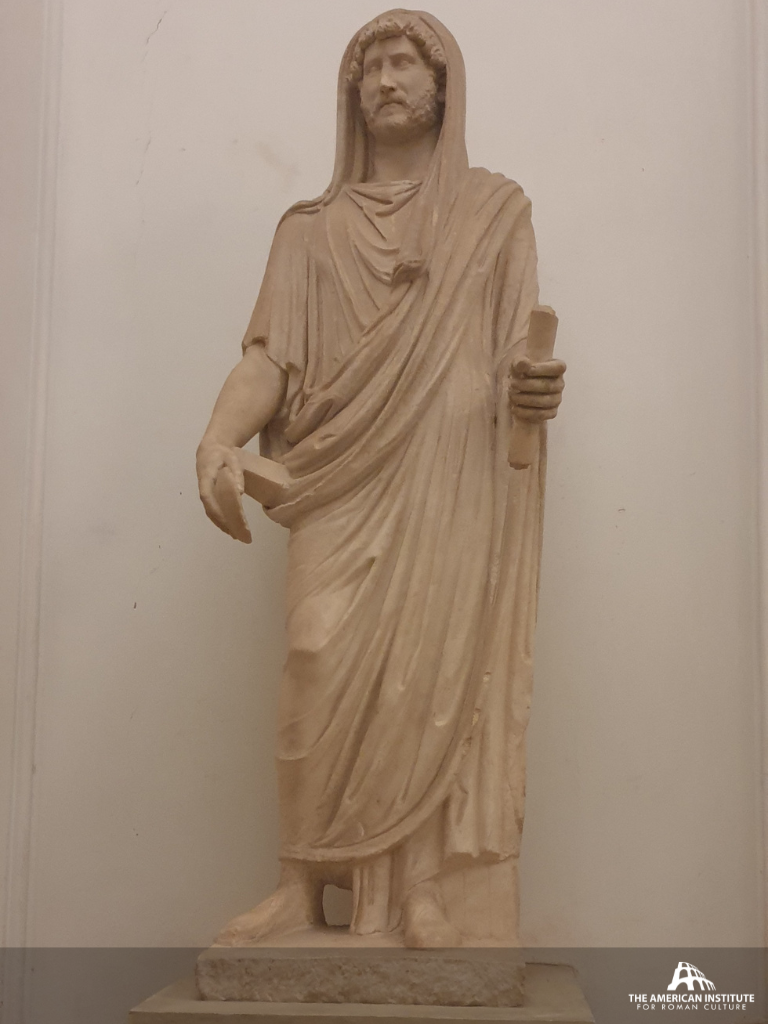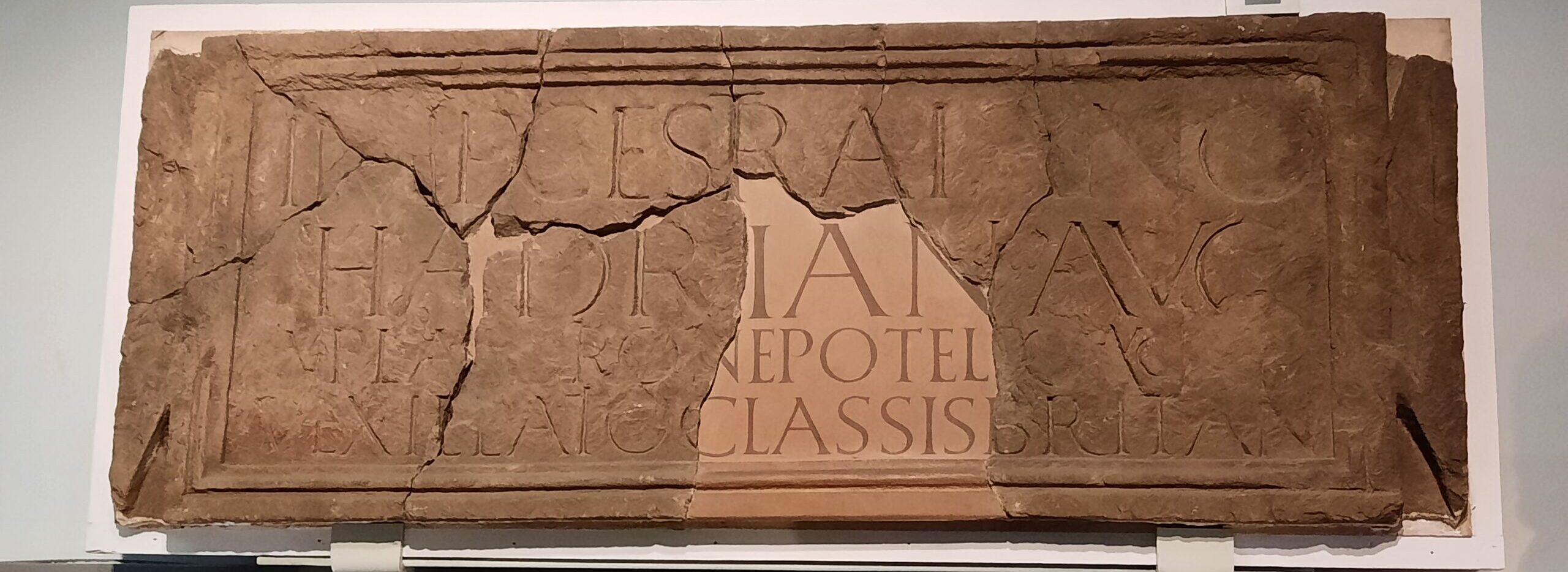Official Name: IMPERATOR CAESAR TRAIANUS HADRIANUS AUGUSTUS
Birthdate: January 24, 76 CE.
(Cassius Dio, Roman History, 69.23) (Historia Augusta, Life of Hadrian, 1)
Birthplace: Hadrian’s birthplace is disputed. Cassius Dio states that he was born in the city of Italica, in the province of Hispania (modern-day Seville, Spain). However, the Historia Augusta claims that he was born in Rome.
(Cassius Dio, Roman History, 69.1) (Historia Augusta, Life of Hadrian, 1)
Reign: Hadrian was named emperor in the will of his predecessor, Trajan. He became emperor on August 10, 117 CE.
(Historia Augusta, Life of Hadrian, 4) (Cassius Dio, Roman History, 69.1)
Marriages: Hadrian married Vibia Sabina, Trajan’s niece, in 100 CE. Their marriage was not a happy one, as Hadrian preferred the company of men and considered his wife to be a headache. Nevertheless, they remained married until Sabina’s death in 136 or 137 CE.
(Historia Augusta, Life of Hadrian, 1 & 11)
Death: Hadrian died of natural causes at his villa in the city of Baiae, Italy. He died on July 10, 138 CE.
(Cassius Dio, Roman History, 69.23) (Historia Augusta, Life of Hadrian, 25)

Bust of Hadrian, British Museum, London, December 2021

Statue of Hadrian as Pontifex Maximus, Musei Capitolini, Rome, May 2019
Hadrian was born in 76 CE near present-day Seville, Spain. Orphaned at the age of ten, he was raised by his cousin Trajan, who later became emperor and helped pave the way for Hadrian’s rise to power. Hadrian was involved in public life from an early age, holding numerous offices and marrying Vibia Sabina, the grandniece of emperor Trajan, in 100 CE. During his youth, Hadrian traveled extensively and spent considerable time in Greece. While there, he developed a deep appreciation for Greek culture, which would profoundly shape his policies as emperor.
When Trajan died in 117 CE, Hadrian ascended to the throne, though questions arose about the legitimacy of his succession. Some sources, such as the Historia Augusta, claim that Trajan officially adopted him. Others, such as Cassius Dio, suggest that his rise was orchestrated by Trajan’s wife, Plotina. Regardless, Hadrian quickly consolidated power and shifted the empire’s focus from expansion to stability. Unlike Trajan, whose conquests had pushed Rome’s borders to their greatest extent, Hadrian prioritized securing and strengthening existing territories. One of his most famous projects, Hadrian’s Wall in northern Britain, physically defined and safeguarded the empire’s frontier.
Hadrian’s love for Greek culture shaped both his policies and personal image. He promoted Athens as the cultural heart of the Roman Empire and became the first emperor to adopt the Greek custom of wearing a beard. Hadrian also had a passion for architecture, combining Greek and Roman styles in his building projects. In Rome, landmarks such as the Pantheon and the Temple of Venus and Roma stand as symbols of his dedication to art, culture, and architectural innovation.
Hadrian’s personal life was complex. His marriage to Vibia Sabina, though lasting nearly forty years, was a political arrangement rather than a romantic partnership and remained childless. Around 125 CE, he formed a deep bond with a Greek youth named Antinous, who became his close companion and lover. When Antinous tragically drowned in the Nile in 130 CE, Hadrian was devastated. In his honor, he deified Antinous and founded the city of Antinoöpolis. The cult of Antinous spread rapidly across the empire, becoming one of the most enduring cults dedicated to a deified individual in Roman history.
While Hadrian was respected for his administrative skill, his reign was not without controversy. His withdrawal from Trajan’s eastern conquests angered the Senate, and his authoritarian streak, including the execution of several senators, strained his relationship with Rome’s elite. Despite this, his reign was largely peaceful and prosperous. He personally toured nearly every province of the empire, working to address local issues and ensure the well-being of the Roman people.
In his final years, facing declining health and no natural heir, Hadrian adopted Antoninus Pius as his successor. In exchange, Antoninus Pius adopted Marcus Aurelius and Lucius Verus, securing the future of the Nerva-Antonine dynasty. Hadrian died of natural causes in 138 CE in his villa at Baiae. Despite some opposition from the Senate, Antoninus Pius had him deified. Today, Hadrian is remembered as one of Rome’s greatest emperors, celebrated for his efforts to consolidate the empire, his patronage of the arts and architecture, and his lasting cultural legacy.
Bibliography:
- Birley, Anthony. (1997). “Hadrian: The Restless Emperor.” Routledge.
- Opper, Thorsten. (2008). “Hadrian: Empire and Conflict.” Harvard University Press.
Further Reading:
- Buckley, Julia. (2024). “How Hadrian’s Wall is Revealing a Hidden Side of Roman History.” CNN. https://www.cnn.com/travel/hadrians-wall-women-history-vindolanda/index.html
- Kitsantonis, Niki. (2024). “Athens’ New Answer to a Water Supply Crunch: An Ancient Aqueduct.” The New York Times. https://www.nytimes.com/2024/12/07/world/europe/greece-athens-hadrians-aqueduct-water.html
- McGreevy, Nora. (2021). “Archaeologists Discover Ruins of Emperor Hadrian’s Ornate Breakfast Chamber.” Smithsonian Magazine. https://www.smithsonianmag.com/smart-news/breakfast-nook-fit-emperor-archaeologists-discover-palace-where-hadrian-dined-180976991/
- Sills, Joe. (2022). “Along Hadrian’s Wall, Ancient Rome’s Temples, Towers, and Cults Come to Life.” National Geographic. https://www.nationalgeographic.com/travel/article/along-hadrians-wall-ancient-romes-temples-towers-and-cults-come-to-life
117
(Historia Augusta, Life of Hadrian, 1)
121
(Historia Augusta, Life of Hadrian, 10-14)
126
(Historia Augusta, Life of Hadrian, 10 & 19)
130
(Cassius Dio, Roman History, 69.11) (Historia Augusta, Life of Hadrian, 13)
This content is brought to you by The American Institute for Roman Culture, a 501(C)3 US Non-Profit Organization.
Please support our mission to aid learning and understanding of ancient Rome through free-to-access content by donating today.
Cite This Page
Cite this page as: Darius Arya, The American Institute for Roman Culture, “Hadrian,” Ancient Rome Live. Last modified 3/2/2025. https://ancientromelive.org/hadrian/
License
Created by The American Institute of Roman Culture, published on 09/02/2022 under the following license: Creative Commons: Attribution-NonCommercial-ShareAlike. This license lets others remix, tweak, and build upon this content non-commercially, as long as they credit the author and license their new creations under the identical terms. Please note that content linked from this page may have different licensing terms.


